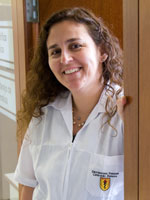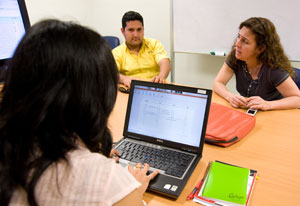Because of a lapse in government funding, the information on this website may not be up to date, transactions submitted via the website may not be processed, and the agency may not be able to respond to inquiries until appropriations are enacted. The NIH Clinical Center (the research hospital of NIH) is open. For more details about its operating status, please visit
cc.nih.gov. Updates regarding government operating status and resumption of normal operations can be found at
opm.gov.
Incorporating ICT into science and research in Peru: Q and A with Patricia Garcia
May / June 2014 | Volume 13, Issue 3

Dr. Patricia Garcia
Patricia Garcia, M.D., PH.D., M.P.H., of the Universidad Peruana Cayetano Heredia in Lima, Peru (UPCH), is dean of the School of Public Health and Administration and adjunct professor in the School of Sciences. A former Fogarty trainee, she helped her institution successfully compete for many of the 40 NIH grants it has secured, as well as for additional funding from a number of foundations and other sources. She is also affiliated with the University of Washington and Tulane University.
How are researchers in Peru incorporating ICT into science?
With computers, cellphones and other information and communications technology (ICT) becoming more widely available, in 1999 we launched a program with Fogarty support to train young professionals in the use, development and application of informatics for health, linking them with ongoing research that uses new technologies. This has achieved considerable success in the development of sustainable biomedical informatics research and training programs in Peru.
How did this lead you to reach out regionally?
At UPCH, we now have the critical mass of professionals, experience and collaborations needed so we decided to take the next step and develop a regional center to train professionals to apply ICT to global health issues and also for developing experts capable of linking informatics with health research. We obtained funding from Fogarty in 2010 to establish this center in the Andean region, where the need is great.
What are some capacity building examples?
The center provides high-quality informatics training to emerging investigators at a fraction of the cost of similar programs in the U.S. Since its launch, the center has created a range of options for emerging investigators, from diplomas to master's degrees to doctoral degrees, and also small grants for innovative, closely mentored research. For instance, one project is improving home blood pressure monitors, another is using bioinformatics for cysticercosis
control and a third is incorporating electronic health records in the fight against tuberculosis.

Photo by David Snyder for Fogarty/NIH
Dr. Patricia Garcia (right) and her colleagues incorporate
information and communications technology (ICT) into research
capacity building projects throughout Peru.
What are some of the challenges?
We are in an era of chaos in informatics. Health authorities are getting all kinds of proposals. Right now, we are investigating how the different systems can talk the same language and become interoperable. We are moving toward linking informatics infrastructure throughout Peru, while maintaining our collaborations with the University of Washington. It is key to have partners from north and south to help train experts in developing countries. We envision global health informatics as an umbrella for integrating health informatics and bioinformatics into clinical, biomedical and behavioral research issues that are critical to advancing the health of populations in our area and around the globe.
What other ways are you employing technology?
To ensure broad access to the new bioinformatics training, both in Peru and other countries, we have placed all our diploma courses and some master’s programs online. Distance learning is very popular, especially with health professionals. But trainees should also have the opportunity for one-on-one interaction, either in person or by videoconference. Along with the bioinformatics courses, trainees can access other relevant training, for instance an online Spanish-language course on the responsible conduct of research. Importantly, online training helps increase the program's sustainability.
What about mobile tools?
Several of our projects are focusing on how text message programs might improve health. We have one that establishes electronic medical records for maternal health and arranges for text messages to pregnant women, designed to motivate them to keep healthy lifestyles and remind them of appointments. We are finishing evaluation of a randomized controlled trial measuring the impact of these messages. We are also working with a trainee to develop a pilot program that continues after the baby is born. An adaptation for rural areas, where some mothers cannot read but have cellphones, is to send voice messages instead, in the local Quechua languages. Another student is working on texts for tuberculosis patients to encourage drug adherence, and a third student is investigating the use of texting for diabetes care. Former trainee Dr. Walter Curioso defended his thesis evaluating the use of cellphones for HIV treatment adherence. So we are creating the critical mass to sustain and expand our progress. We are positioned as a leader in the field.
More Information
To view Adobe PDF files,
download current, free accessible plug-ins from Adobe's website.